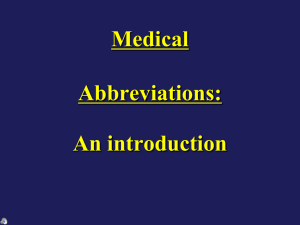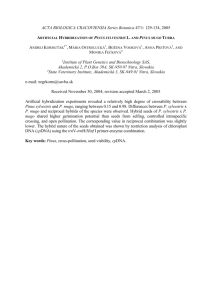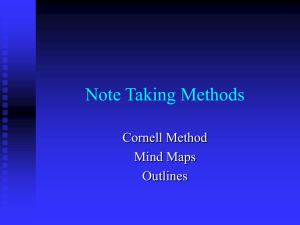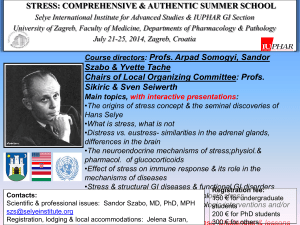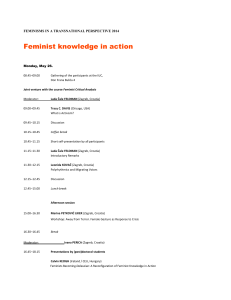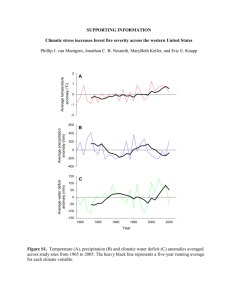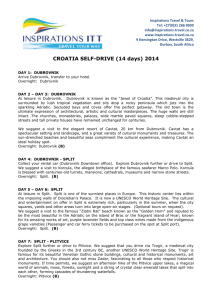Airborne Laser Scanning - the State and Perspectives for the
advertisement
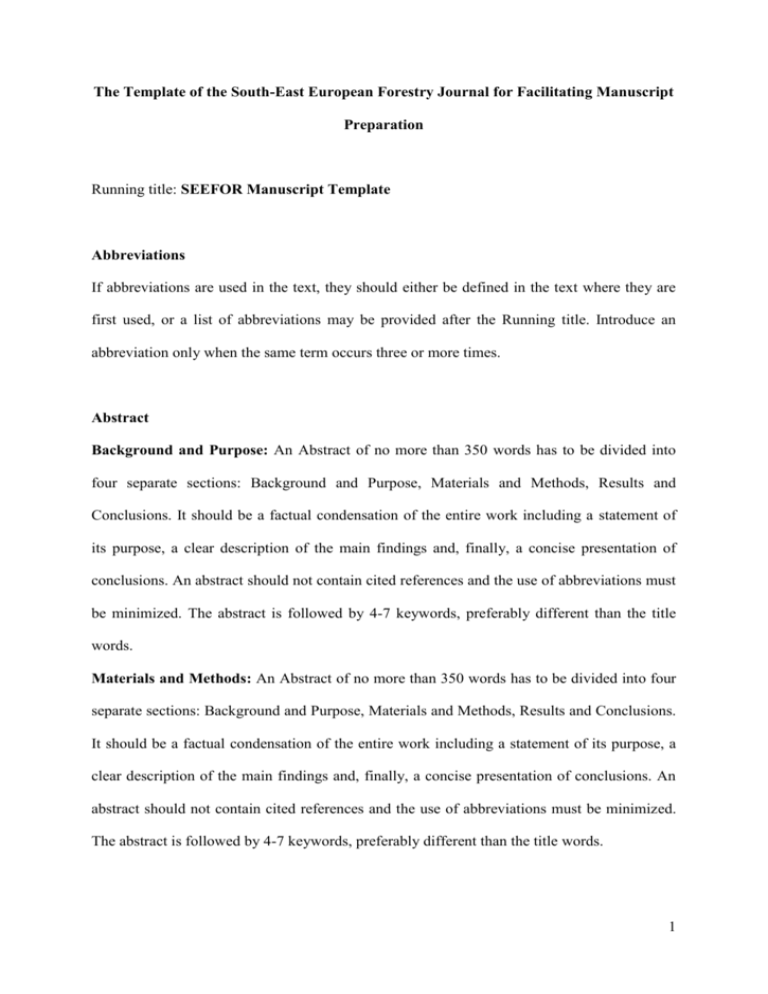
The Template of the South-East European Forestry Journal for Facilitating Manuscript Preparation Running title: SEEFOR Manuscript Template Abbreviations If abbreviations are used in the text, they should either be defined in the text where they are first used, or a list of abbreviations may be provided after the Running title. Introduce an abbreviation only when the same term occurs three or more times. Abstract Background and Purpose: An Abstract of no more than 350 words has to be divided into four separate sections: Background and Purpose, Materials and Methods, Results and Conclusions. It should be a factual condensation of the entire work including a statement of its purpose, a clear description of the main findings and, finally, a concise presentation of conclusions. An abstract should not contain cited references and the use of abbreviations must be minimized. The abstract is followed by 4-7 keywords, preferably different than the title words. Materials and Methods: An Abstract of no more than 350 words has to be divided into four separate sections: Background and Purpose, Materials and Methods, Results and Conclusions. It should be a factual condensation of the entire work including a statement of its purpose, a clear description of the main findings and, finally, a concise presentation of conclusions. An abstract should not contain cited references and the use of abbreviations must be minimized. The abstract is followed by 4-7 keywords, preferably different than the title words. 1 Results: An Abstract of no more than 350 words has to be divided into four separate sections: Background and Purpose, Materials and Methods, Results and Conclusions. It should be a factual condensation of the entire work including a statement of its purpose, a clear description of the main findings and, finally, a concise presentation of conclusions. An abstract should not contain cited references and the use of abbreviations must be minimized. The abstract is followed by 4-7 keywords, preferably different than the title words. Conclusions: An Abstract of no more than 350 words has to be divided into four separate sections: Background and Purpose, Materials and Methods, Results and Conclusions. It should be a factual condensation of the entire work including a statement of its purpose, a clear description of the main findings and, finally, a concise presentation of conclusions. An abstract should not contain cited references and the use of abbreviations must be minimized. The abstract is followed by 4-7 keywords, preferably different than the title words. Keywords: keyword1, keyword2, keyword3, keyword4, keyword5, keyword6, keyword7 INTRODUCTION Keep the Introduction brief, stating clearly the purpose of the research and its relation to other papers on the same subject. Do not give an extensive review of literature [1]. Text text text text text text [2]. Text text text text text text text text [3-6]. Text text text text text text text text text text text text text text text text text text text text text text text text [2, 3]. According to Vuletić et al. [2] the influence of text text text text text text text text text text text text text text text text text text text text text text text text text text text text text text text text text text text text text text text text text text text text text. Marjanović et al. [2] stated that text text text text text text text text text text text text text text text text text text text text text text. 2 Text text text text text text [7]. Text text text text text text text text [8]. Text text text text text text text text text text text text text text text text text text text text text text text text [9]. Text text text text text text. Text text text text text text text text. Text text text text text text text text text text text text text text text text text text text text text text text text. Text text text text text text. Text text text text text text text text. Text text text text text text text text text text text text text text text text text text text text text text text text. MATERIALS AND METHODS Provide enough information in the Material and Methods section to enable other researchers to repeat the study. This section may be divided into subsections (Study Area, Field Measurement, Statistical Analysis, etc.), but it is optional. Study area Text text text text text text. Text text text text text text text text. Text text text text text text text text text text text text text text text text text text text text text text text text. Text text text text text text [10]. Text text text text text text text text. Text text text text text text text text text text text text text text text text text text text text text text text text Subsection Text text text text text text. Text text text text text text text text. Text text text text text text text text text text text text text text text text text text text text text text text text. Text text text text text text. Text text text text text text text text. Text text text text text text text text text text text text text text text text text text text text text text text text (Figure 1). Text text text text text text text text. FIGURE 1. Title of the figure 3 RESULTS Report results clearly and concisely. Do not present the same results in tables and illustrations. Exceptionally, Results and Discussion may be combined in a single section. This section may be divided into subsections, but it is optional. Text text text text text text. Text text text text text text text text (Table 1). Text text text text text text text text text text text text text text text text text text text text text text text text. Text text text text text text. Text text text text text text text text. Text text text text text text text text text text text text text text text text text text text text text text text text. TABLE 1. Title of the table Text text text text text text. Text text text text text text text text. Text text text text text text text text text text text text text text text text text text text text text text text text (Table 2). Text text text text text text. Text text text text text text text text. Text text text text text text text text text text text text text text text text text text text text text text text text. FIGURE 2. Title of the table DISCUSSION Interpret the results in the Discussion, state their meaning and draw conclusions. Do not simply repeat the results. This section may be divided into subsections, but it is optional. Text text text text text text [2, 11]. Text text text text text text text text [12-15]. Text text text text text text text text text text text text text text text text text text text text text text text text. Text text text text text text text text text text text text text text text text text text text text text text text text. Text text text text text text text text text text text text text text text text text text text text text text text text. 4 CONCLUSIONS List your conclusions in a short, clear and simple manner. State only those conclusions that stem directly from the results shown in the paper. Acknowledgments Acknowledgments of people, grants, funds, etc. that contributed to the research should be placed in a separate section before the Reference section. REFERENCES 1. PERNEK M, LACKOVIĆ N, MATOŠEVIĆ D 2013 Biology and natural enemies of spotted ash looper, Abraxas pantaria (Lepidoptera, Geometridae) in Krka National Park. Period Biol 115 (3): 371-377 2. VULETIĆ D, AVDIBEGOVIĆ M, STOJANOVSKA M, NEVENIĆ R, HASKA H, POSAVEC S, KRAJTER S, PERI L, et al. 2013 Contribution to the understanding of typology and importance of forest-related conflicts in South East Europe region. Period Biol 115 (3): 385-390 3. MARJANOVIĆ H, OSTROGOVIĆ MZ, ALBERTI G, BALENOVIĆ I, PALADINIĆ E, INDIR K, PERESSOTTI A, VULETIĆ D 2011 Carbon Dynamics in younger Stands of Pedunculate Oak during two Vegetation Periods (in Croatian with English summary). Sumar list, 134 (11-12): 59-73 4. VULETIĆ D, POTOČIĆ N, KRAJTER S, SELETKOVIĆ I, FÜRST C, MAKESCHIN F, GALIĆ Z, LORZ C, at al. 2009 How Socio-Economic Conditions Influence Forest Policy Development in Central and South-East Europe. Environ Manage 46 (6): 931940. DOI: 10.1007/s00267-010-9566-3 5 5. MATOŠEVIĆ D 2013 Box Tree Moth (Cydalima perspectalis, Lepidoptera; Crambidae), New Invasive Insect Pest in Croatia. South-East Eur For 4 (2): (early view). URL: http://www.seefor.eu/36-vol4-no2-matosevic.html (20 December 2013) 6. ANČIĆ M, PERNAR R, BAJIĆ M, SELETKOVIĆ A, KOLIĆ J 2013 Detecting mistletoe infestation on Silver fir using hyperspectral images. iForest (early view). DOI: 10.3832/ifor1035-006 7. BALENOVIĆ I, SELETKOVIĆ A, PERNAR R, MARJANOVIĆ H, VULETIĆ D, BENKO M 2012 Comparison of Classical Terrestrial and Photogrammetric Method in Creating Management Division. In: Pentek T, Poršinsky T, Šporčić M (eds) Forest Engineering - Concern, Knowledge and Accountability in Today’s Environment, Proceedings of 45th International Symposium on Forestry Mechanization, Croatia, Dubrovnik, 8-12 October 2012. Forestry Faculty of University Zagreb, Zagreb, Croatia, pp 1-13 8. VAN LAAR A, AKÇA A 2007 Forest Mensuration. Springer, Berlin, Germany, 383 p 9. CURTIS PS 2008 Estimating Aboveground Carbon in Live and Standing Dead Trees. In: Hoover CM (ed) Field Measurements for Forest Carbon Monitoring. Springer, New York, NY, USA, pp 240 10. OSTROGOVIĆ MZ 2013 Carbon stocks and carbon balance of an even-aged Pedunculate Oak (Quercus robur L.) forest in Kupa river basin. PhD thesis, University of Zagreb, Faculty of Forestry, Zagreb, Croatia, 130 p 11. LEMMENS M 2011 Digital Photogrammetric Workstations, Status and Features. GIM International 25 (12). URL: http://www.gim-international.com/issues/articles/id1797Digital_Photogrammetric_Workstations.html (20 November 2012) 6 12. CROATIAN FORESTS LTD 2013 Forests in Croatia. http://portal.hrsume.hr/index.php/en/forests/general/forests-in-croatia (14 URL: December 2013) 13. DOBBERTIN M, NEUMANN M 2010 Tree Growth. Manual Part V. In: Manual on methods and criteria for harmonized sampling, assessment, monitoring and analysis of the effects of air pollution on forests. UNECE ICP Forests Programme Co-ordinating Centre, Hamburg, Germany, 29 p. URL: http://www.icp-forests.org/Manual.htm (12 December 2013) 14. FAO 2012 State of the World’s Forests 2012. Food and Agriculture Organization of the United Nations, Rome, Italy, 47 p. URL: http://www.fao.org/docrep/016/i3010e/i3010e.pdf (12 December 2013) 15. THE MINISTRY OF AGRICULTURE, FORESTRY AND WATER MANAGEMENT 2006 Regulation on forest management (in Croatian). Official Gazette 111/06, Zagreb, Croatia. URL: http://narodne-novine.nn.hr/clanci/sluzbeni/128205.html (10 December 2013) 7 TABLE 1. Title of the table Subcompartment Area (ha) Basal area (m2·ha-1) Volume (m3·ha-1) 5a 4.2 22.7 154.1 5b 3.0 23.8 203.2 10a 5.4 24.7 241.1 10b 5.1 25.4 278.4 8 TABLE 2. Title of the table Results RMSE (m) Research area Tree species Δ ± SD (m) Norway Picea abies, Pinus sylvestris -0.18 ± 3.15 n/a 0.75 n/a 0.65 0.72 0.64 0.64 0.76 n/a -1.27 n/a n/a Sweden UK Picea abies, Pinus sylvestris Deciduous R2 Canada Pseudotsuga menziesii -1.32 ± 0.81 n/a 0.84 Finland Pinus sylvestris -0.65 ± 0.49 n/a 0.99 n/a 0.6 0.92 Switzerland Pinus montana, P.cembra Idaho, USA Coniferous - 1.07 2.64 0.94 Sweden Deciduous -1.20 ± 6.40 n/a n/a n/a - not available Δ - mean difference between tree heights derived from Lidar and by terrestrial measurement; SD - standard deviation; RMSE – root mean square error; R2 – coefficient of determination 9 FIGURE 1. Title of the figure 10 Supplementary Files File name: File format: Title: Description of Data: 11
